Mula field work
Students of the third course of Geology of the Alicante University within the subject of Mapping 2: visit North of Mula village. Working in the Malaguide complex non-metamorphic rocks.
The visit took place from October 21th until 24th of 2020 and the professor in charge was Manuel Martín-Martín.
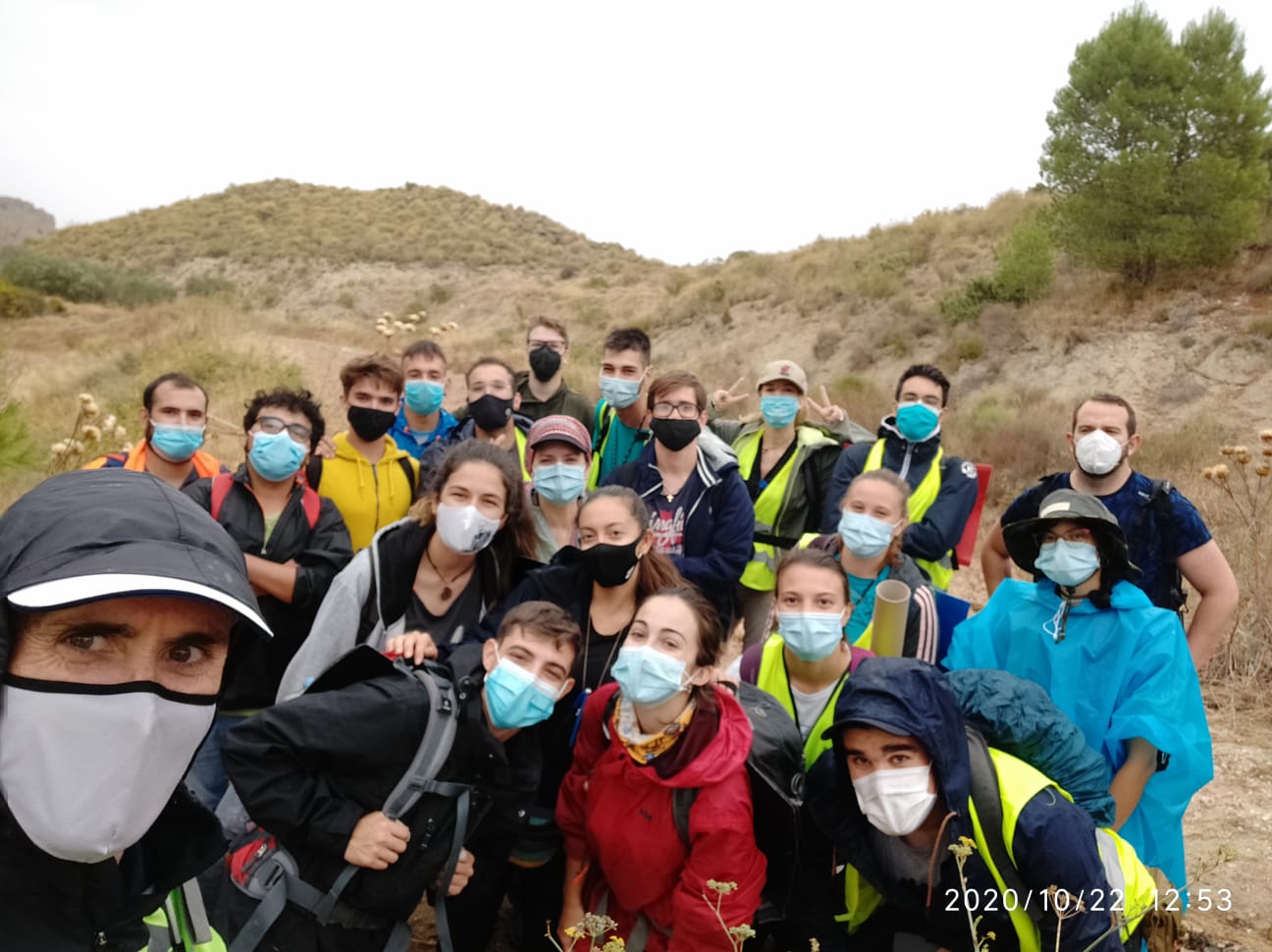
The Huelva Group: Josep Tosquella

Josep Tosquella Angrill graduated in Geological Sciences in 1985 from the University of Barcelona. He obtained his doctorate from the University of Barcelona in 1995, having studied the Nummulitinae of the Paleocene-Early Eocene of the south-Pyrenean Basin. Their teaching history begins at the Faculty of Geology of the University of Barcelona as Assistant Professor LRU (1990-1998). From 1999 to 2001 teach as a Full-time Associate Professor in the Department of Geology of the Faculty of Experimental Sciences of the University of Huelva, and on October 17 of 2001 he take part as Full University Professor at this University at the Department of Earth Sciences (Palaeontology area). His recent research activity is mainly focused on the following lines: a) Large Benthic Foraminifera (Nummulitids) in the Cenozoic sediments of the Pyrenean, Betic and Vasco-Cantabrian areas: Systematics, Paleoecology, Paleobiogeography, Biochronostratigraphy and usefulness in Intercontinental Stratigraphic Correlations, and b) Geoarchaeology of the Tinto-Odiel Estuary (Huelva, SW Spain): Morphosedimentary evolution and peopling.
Recent papers:
- Martín-Martín, M., Guerrera, F., Tosquella, J., Tramontana, M., Paleocene-Lower Eocene carbonate platforms of westernmost Tethys. Sedimentary Geology, 404, 105674.
- Ruiz, F., Rodríguez-Vidal, J.,Cáceres, L.M.,Olías, M., González-Regalado, M.L., Campos, J.M., Bermejo, J., Abad, M., Izquierdo, T.,Carretero, M.I.,Pozo, M.,Monge, P.,Tosquella, J., Prudencio, M.I., Dias, M.I.,Marques, R., Gómez, P., Toscano, Romero, V., 2020. Silver and copper as pollution tracers in Neogene to Holocene estuarine sediments from southwestern Spain. Marine Pollution Bulletin, 150, 110704.
- Ruiz, F., Gómez, G., González-Regalado, M.L., Rodríguez-Vidal, J.,Cáceres, L.M.,Gómez, P., Clemente, M.J., Bermejo, J., Campos, J., Toscano, A., Abad, M., Izquierdo, T., Muñoz, J.M., Carretero, M.I.,Prudencio, M.I.,Dias, M.I.,Marques, R.,Tosquella, J., Monge, P., 2020. A multidisciplinary analysis of shell deposits from Saltés Island (SW Spain): The origin of a new Roman shell midden. Palaeogeography, Palaeoclimatology, Palaeoecology, 538, 109416.
- González-Regalado, M.L., Romero, V., Abad, M., Tosquella, J., Izquierdo, T., Gómez, P., Clemente, M.J., Toscano, A., Rodríguez-Vidal, J., Cáceres, L.M., Muñoz, J.M., Prudêncio, M.I., Dias, M.I., Marques, R., García, E.X.M., Carretero, M.I., Ruiz, F., Monge, G., 2019. Late Tortonian-Middle Messinian palaeoenvironmental changes in the western Betic Strait (SW Spain). Ameghiniana, 56 (4), 336-360.
- Astibia, H., Payros, A., Ortiz, S., Elorza, J., Álvarez-Pérez, G., Badiola, A., Bardet, N., Berreteaga, A., Calzada, S., Corral, J.C., Díaz-Martínez, I., Merle, D., Pacaud, J.M., Pereda-Suberbiola, X., Pisera, A., Rodríguez-Tovar, F., Tosquella, J., Bitner, M.A., 2016. Fossil associations from the middle and upper Eocene strata of the Pamplona Basin and surrounding areas (Navarre, western Pyrenees). Journal of Iberian Geology, 42 (1), 7-28.
- Payros, A., Pujalte, V., Orue-Etxebarria, X., Apellaniz, E., Bernaola, G., Baceta, J.I., Caballero, F., Dinarès-Turell, J., Monechi, S., Ortiz, S., Schmitz, B. y Tosquella, J., The relevance of iberian sedimentary successions for paleogene stratigraphy and timescales. In Montenari, M. (Ed.): Stratigraphy & Timescales (Vol. I): 393-466, Academic Press publications, ELSEVIER, Amsterdam.
- Molina, E., Alegret, L., Apellaniz, E., Bernaola, G., Caballero, F., Dinarès-Turell, J., Hardenbol, J., Heilmann-Clausen, C., Larrasoaña, J.C., Luterbacher, H.P., Monechi, S., Ortiz, S., Orue-Etxebarria, X., Payros, A., Pujalte, V., Rodríguez-Tovar, F., Tosquella, J. y Uchman, A., 2011. The Global Stratotype Section and Point (GSSP) for the base of the Lutetian Stage at the Gorrondatxe section, Spain. Episodes, 34 (2), 86-108.
- Payros, A., Dinarès-Turell, J., Bernaola, G., Orue-Etxebarria, X., Apellaniz, E. y Tosquella, J., 2011. On the age of the Early/Middle Eocene boundary and other related events: cyclostratigraphic refinements from the Pyrenean Otsakar section and the Lutetian GSSP. Geological Magazine, 148 (3), 442-460.
- Astibia, H., Bardet, N., Pereda-Suberbiola, X., Payros, A., Buffrénil, V. de, Elorza, J., Tosquella, J., Berreteaga, A. y Badiola, A., 2010. New fossils of Sirenia from the Middle Eocene of Navarre (Western Pyrenees): the oldest West European sea cow record. Geological Magazine, 147 (5), 665-673.
- Payros, A., Pujalte, V., Tosquella, J. y Orue-Etxebarria, X., 2010. The Eocene storm-dominated foralgal ramp of the western Pyrenees (Urbasa-Andia Formation): an analogue of future shallow-marine carbonate systems?Sedimentary Geology, 228 (3-4), 184-204.

The Granada Group: Antonio Sánchez-Navas
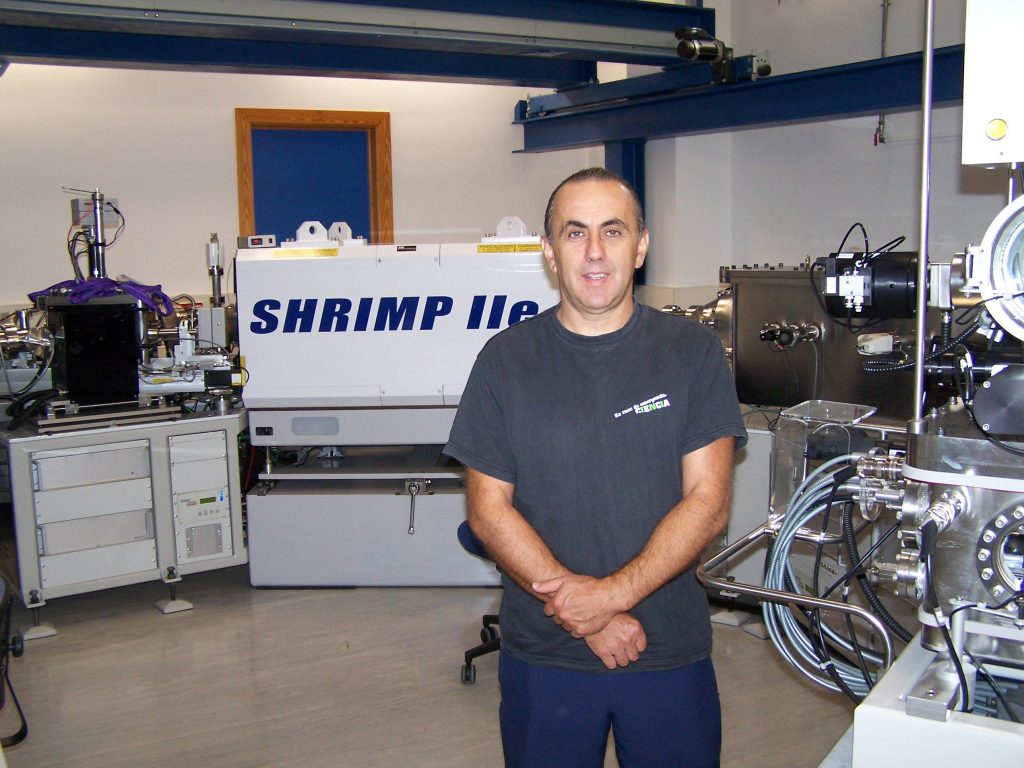
Antonio Sánchez-Navas has been doing research in the fields of crystallography, mineralogy and petrology. The publication list of mineralogy includes papers in American Mineralogist, European Journal of Mineralogy, Canadian Mineralogist y Clays and Clay minerals. His research activities focussed on the field of crystallography have been published in Crystal Growth and Design and Journal of Crystal Growth. Publications about geochemistry include papers in important international journals as Geochimica et Cosmochimica y Chemical Geology; about Geology, in journals as Geology, Journal of Geology, Journal of Metamorphic Geology and Terranova; about sedimentology in Sedimentology; about environmental sciences and cultural heritage in Journal of Geophysical Research, Atmospheric Environment, Geoderma, Archaeometry and Journal of Cultural Heritage. He has worked as scientific and technical advisor of the Scientific Instrumentation Center of the University of Granada (1989-present). Among the works carried out, it is worth mentioning the development of the backscattered electron diffraction (EBSD) for the textural analysis of geological materials in our laboratories.
– López-Quirós, A., Sánchez-Navas, A., Nieto, F., Escutia C. (2020): New insights into the nature of glauconite. American Mineralogist, 105, 674-686. https://doi.org/10.2138/am-2020-7341.
– Chen, X. Y., Teng, F. Z., Sanchez, W. R., Romanek, C. S., Sanchez-Navas, A., Sánchez-Román, M.(2020): Experimental constraints on magnesium isotope fractionation during abiogenic calcite precipitation at room temperature. Geochimica et Cosmochimica Acta, 281, 102-117. https://doi.org/10.1016/j.gca.2020.04.033.
– López-Quirós, A., Escutia, C., Sánchez-Navas, A., Nieto, F., Garcia-Casco, A., Martín-Algarra, A., Evangelinos, D., Salabarna, A. (2019) Glaucony authigenesis, maturity and alteration in the Weddell Sea: An indicator of paleoenvironmental conditions before the onset of Antarctic glaciation. Scientific Reports 9:13580. https://doi.org/10.1038/s41598-019-50107-1.
– Hernández-Laguna, A., Pérez del Valle, C., Hernández-Haro, N., Ortega-Castro, J., Muñoz-Santiburcio, D., Vidal, I., Sánchez-Navas, A., Escamilla-Roa, E., Sainz-Díaz, C. I. (2019): Compressibility of 2M1 muscovite-phlogopite series minerals. Journal of Molecular Modeling 25:341. https://doi.org/10.1007/s00894-019-4218-x.
– Farré-de-Pablo, J., Proenza, J. A., González-Jiménez, J. M., Garcia-Casco, A., Colás, V., Roqué-Rossell, J., Camprubí, A., Sánchez-Navas, A. (2018): A shallow origin for diamonds in ophiolitic chromitites. Geology, 47 (1), 75-78. https://doi.org/10.1130/G45640.1.
– Díaz-Hernández, J. L., Sánchez-Navas, A., Delgado, A., Yepes, J., García-Casco, A. (2018): Textural and isotopic evidence for Ca-Mg carbonate pedogenesis. Geochimica et Cosmochimica Acta, 222, 485-507. doi: 10.1016/j.gca.2017.11.006.
– Sánchez-Navas, A., García-Casco, A., Mazzoli, S., Martín-Algarra, A. (2017): Polymetamorphism in the Alpujarride Complex, Betic Cordillera, south Spain. The Journal of Geology, 125, 637-657. doi: 10.1086/693862.
University of Alicante Group: Dr. Manuel Martín-Martín
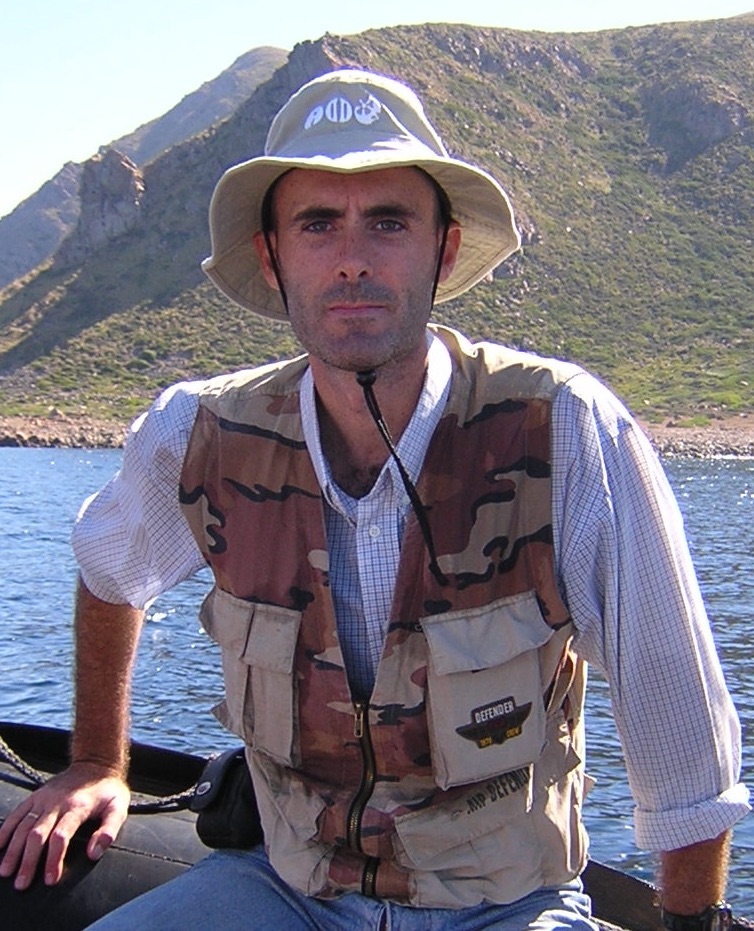
Manuel Martín Martín graduated in Geological Sciences from the University of Granada in 1990. He obtained a research grant from the FPI plan of the Ministry of Education and Science (1993-1996) and received his doctorate from the University of Granada in 1996, having studied the Tertiary of Maláguide Domain in Sierra Espuña (Bética Internal Zones). He obtained a postdoctoral fellowship from the FPI plan of the Ministry of Education and Science (1997-1998) to study the Paleogene of the Corbiéres and Minervois sector (SE, France) at the Université Paul Sabatier in Toulouse (France). He is professor at the University of Alicante from the end of 1998. Since July 25, 2002, he has been a Full Professor at the University of Alicante at the Department of Earth and Environmental Sciences (Internal Geodynamics area). Currently he is working on the tectono-sedimentary evolution of Cenozoic basins, being the Head Researcher of the Group of the University of Alicante: “Geodynamic evolution of the eastern Betic mountain range and the Alicante marine platform”.
Recent papers:
Terminology revision of AlKaPeCa and Mesomediterranean Microplate
The use of terms strictly related to the original formulation of different models caused, in some cases, inaccuracies in the univocal identification of some main palaeogeographic elements.
Bouillin et al. (1986) introduced the acronym AlKaPeCa for a lithospherical block formed by Alboran-Kabylian-Peloritan-Calabrian Internal Zones, Alpine units. According to them the relationships between AlKaPeCa and the Maghrebian Flysch Basin may be synthesized as follows:‘ the only possible oceanic zone known between Western Europe and Africa, at the Jurassic time, corresponds to the basement of the Flyschs which was located southward of AlKaPeCa’ .
Many palaeogeographic interpretations of the Jurassic-Cretaceous evolution of the Betic, Maghrebian and Apennine Chains have been roughly grouped into two main general families: (1) Type A models: they state the presence of a single oceanic area (i.e., the Tethys) located between the African and European Plates; (2) Type B models: they consider the occurrence of two oceanic branches of the Tethys surrounding one or more microcontinents located between the African and European Plates. Both classes of models imply a different evolution during the Pangea breakup and during the Cretaceous-Cenozoic convergence. According to Type A models the Pangea broke with a single oceanic branch located between Europe and Africa, meanwhile according to Type B models the fragmentation was more complex leading to two oceanic branches with several microplates located between Europe and Africa.
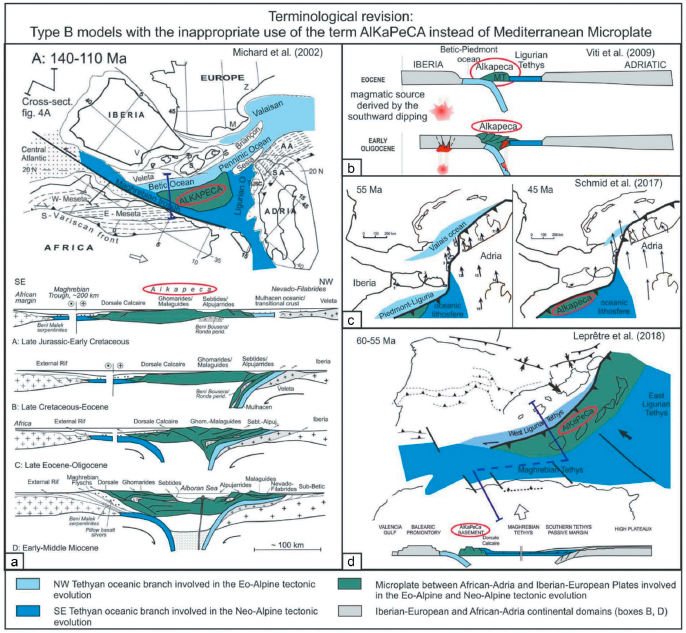
According to Guerrera et al. (2019) the original meaning of AlKaPeCa should be reserved to indicate a detached piece of the European Margin while the Mesomediterranean Microplate should be used exclusively for the independent microplate even though during the Maghrebian- Apennine orogeny these elements actually coincide to form the Internal Zones of these chains. For this reason, the use of this acronym is not appropriate for models which consider the occurrence of an independent microplate surrounded by different oceanic branches of the Tethys since Mesozoic. A more common name used in literature for this microplate is the Mesomediterranean Microplate.
Evolutionary geological models of the central-western peri-Mediterranean chains
Two main groups of geological models presented over the last four decades on the paleogeographic, paleotectonic and geodynamic eo-Alpine and neo-Alpine evolution of the central-western Mediterranean area were compared. The comparison was carried out mainly considering the main stratigraphic, sedimentological, petrographic, structural and plate tectonic constraints. Moreover, recent geophysical interpretations and reconstructions were also considered with an aim of presenting all the different results. The models can roughly be grouped into two main classes. First family considers the presence of the Mesozoic Tethyan Ocean, where a single oceanic basin is located between Africa and Europe and from which both eo-Alpine and neo-Alpine chains were generated during the Cretaceous to Miocene time span. Conversely, the other class considers the occurrence of at least two Tethyan oceanic branches (or with thinned continental crust) since the Jurassic, separated by one or more microcontinents. The pros and cons of both classes of models are presented. Progressive innovations and improvements to the two groups of models were proposed over the years. However, because the modelsare based on different data sets resulting from basic geological studies or obtained by means of other approaches, they often do not integrate easily.This caused interpretative difficulties and terminological uncertainties for their comparison, and completely different models were considered equivalent and, sometimes, the same terminology was used indifferently to identify different geological subjects. The main differences between the examined models concern the kinematic reconstructions and by hence in the paleogeographic and paleotectonic interpretations. The discussion presented in this paper aims at contributing to clarify and update the state of knowledge on this controversial topic.
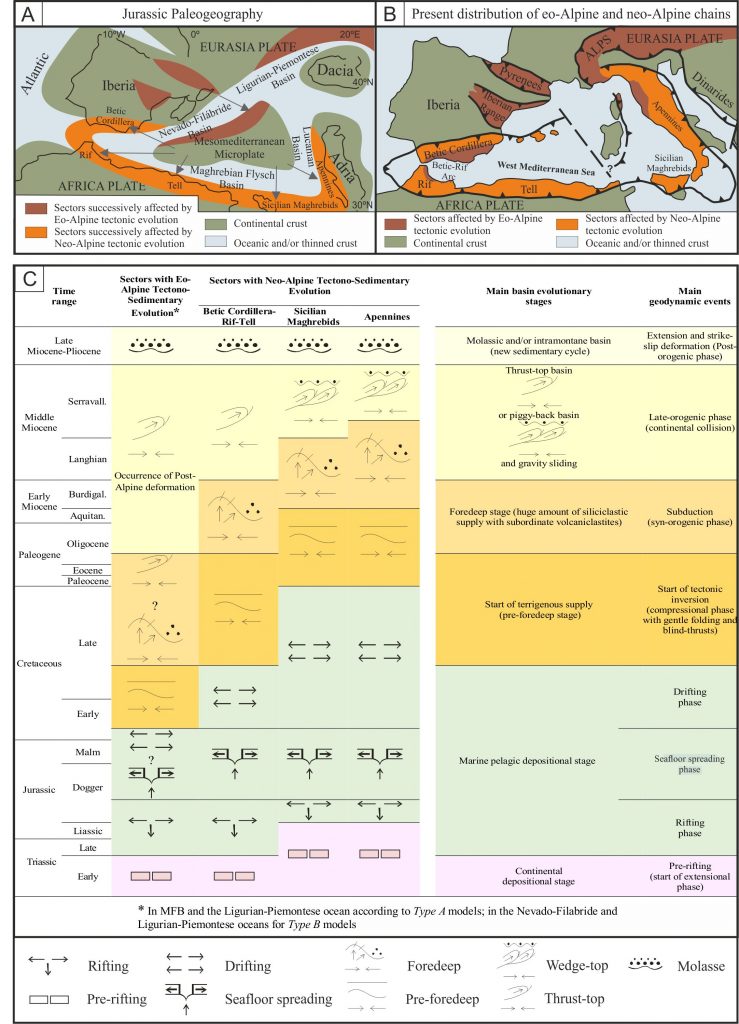
Compactation in sedimentary basins
Subsidence analysis is an important technique in the study of sedimentary basins but the effects of compaction must be “backstripped”. The compaction of sediments is also of importance for petroleum and water reservoir research with very important economic derivations. Most methods for calculating compaction are based on empirically derived porosity-depth relationships from a variety of known sediment types. The challenge of this paper is to apply alternative methods for calculating compaction in sedimentary basins based on: physical calculation with elastic by Steinbrenner, oedometric and change of the specific weight of the sediment methods; and use of Loadcap software.
The Triassic to Lower Miocene 3025m thick succession of Sierra Espuña (SE Spain) is used as case study for the calculations. In this succession former mineralogical studies and apatite fission-track suggested an original thickness between 4 and 6km. The validity of each one of the proposed methods is discussed, as well as, compared for the whole succession compaction but also separately for hard vs soft sediments and for thick vs thin beds.
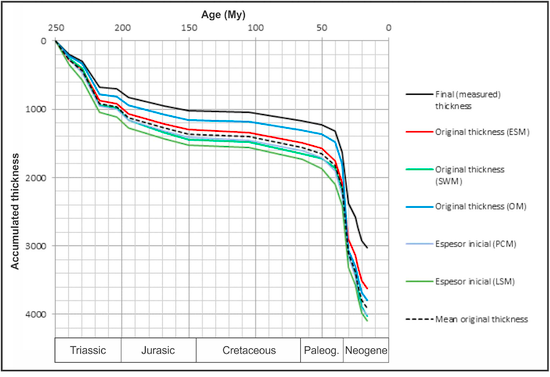
The compaction values obtained with the alternative methods are similar to those resulting with the lower-limit curves of the porosity-depth change method. The new methods have provided values slightly higher than 4km for the whole original thickness using the geotechnical software and the change of the sediments specific weigh methods; meanwhile values below 4km for other methods. So, in our opinion, the geotechnical software and the change of the specific weight of the sediment methods are compatible with mineralogical constraints and also, the input data are usually better known and easier to determinate. Otherwise, the elastic method seems only accurate for soft sediments; meanwhile the oedometric method is highly influenced by the thickness of the considered beds.
Latest Chattian-Langhian Volcano- Sedimentary Event
High amounts of Chattian-Langhian orogenic magmatism have generated volcaniclastic deposits that are interbedded within the penecontemporaneous sedimentary marine successions in several central-western peri-Mediterranean chains. These deposits are widespread in at least 41 units of different basins located in different geotectonic provinces: (1) the Africa-Adria continental margins (external units), (2) the basinal units resting on oceanic or thinned continental crust of the different branches of the western Tethys, (3) the European Margin (external units), and (4) the Western Sardinia zone (Sardinia Through units). The emplacement of volcaniclastic material in marine basins was controlled by gravity flows (mainly turbidites; epiclastites) and fallout (pyroclastites). A third type comprises volcaniclastic grains mixed with marine deposits (mixed pyroclastic-epiclastic). Calc-alkaline magmatic activity is characterized by a medium- to high-potassium andesite-dacite-rhyolite suite and is linked to complex geodynamic processes that affected the central-western Mediterranean area in the ∼26 to 15 My range. The space/time distribution of volcaniclastites, together with a paleogeographic reconstructions, provide keys and constraints for a better reconstruction of some geodynamic events. Previous models of the central-western Mediterranean area were examined to compare their compatibility with main paleotectonic and paleogeographic constraints presented by the main results of the study. Despite the complexity of the topic, a preliminary evolutionary model based on the distribution of volcaniclastites and active volcanic systems is proposed.

Oligo-Miocene evolution of the Paratethyan branches
A comparison of the stratigraphic record between two different branches of the Tethys is attempted for the first time. This study concerns the main Oligocene-Miocene tectono-sedimentary events in the Cenozoic units of the Moldavidian Basin (Romanian Eastern Carpathians) and the Maghrebian Flysch Basin (Maghrebian Chain and its lateral extension in the Betic and Southern Apennine Chains). Both basins are characterized by three main general Oligo-Miocene successions (internal, mixed, and external) corresponding to three subdomains controlled by the geological evolution of opposite plate (or microplate) margins and affected by a similar tectonic evolution. The successions of the three subdomains of the two basins show very similar features regarding stratigraphic records (lithofacies and petrofacies associations, unconformities, marker-levels, age), and the space-time sediment supply diversification (i.e., immature and super-mature arenites coming from opposite margins). Furthermore, pre-, syn- and post-orogenic successions have been identified in the geological reconstructions of both basins. The tectonic control on depositional processes (i.e., a large amount of siliciclastic supply confined in restricted time ranges, widespread volcaniclastites linked to acid-intermediate penecontemporaneous volcanic activity), and the appearance of indicators of syn-sedimentary tectonic activity (turbidites, slumps, and olistostromes) result in correlable events related to deformation phases that in turn are indicative of a similar evolution. Also, the basinal evolutionary stages (i.e., beginning of terrigenous supply, thrust-top basin formation and gravitational sliding, molassic and/or intramontane sedimentary cycles), the timing of deformation phases (drifting, foredeep), and geotectonic events (from extension to compression and post-orogenic deformation) seem to be similar. All results are encompassed in an evolutionary geodynamic model considered in the context of the Africa-Europe convergence where intermediate microplates are involved. This complex framework implies a progressive reorientation of convergence direction of these microplates that occurs during similar geodynamic events leading to the closure of the western Tethys Ocean and its related late-Alpine branches. This comparative approach, if applied to similar evolutionary phases of other mountain chains, can be useful for different geological contexts of other orogenic belts, especially to check the major general geological constraints for their evolution.
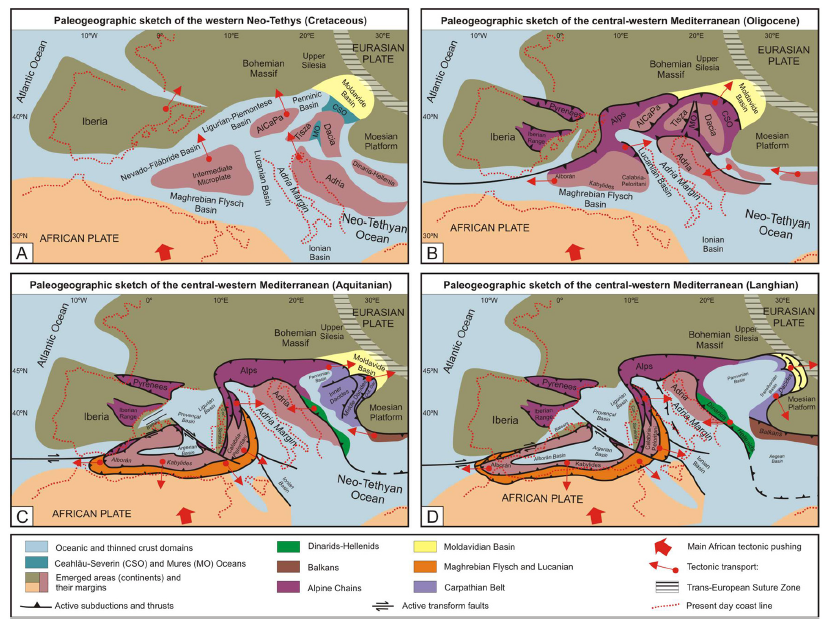
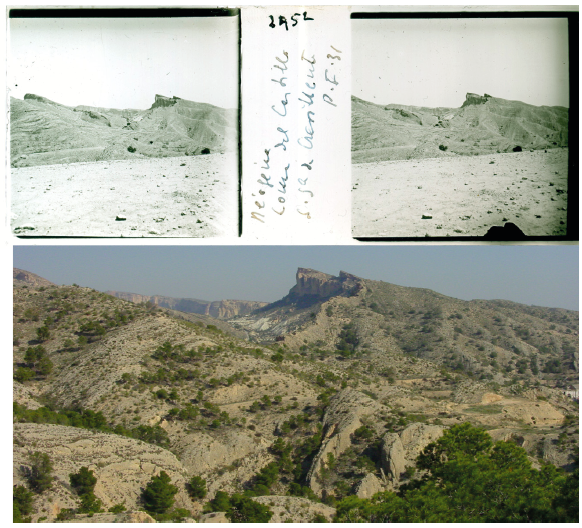
Recent Comments